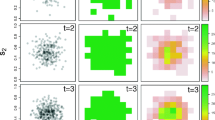Abstract
Two equations have been used frequently to describe the relation between the sample variance (s 2) and sample mean (m) of the number of individuals per quadrat: Taylor's power law, s 2 = am b, and Iwao's m *−m regression, s 2 = cm + dm 2, where a, b, c, and d are constants. We can obtain biological information such as colony size and the degree of aggregation of colonies from parameters c and d of Iwao's m *−m regression. However, we cannot obtain such biological information from parameters a and b of Taylor's power law because these parameters have not been described by simple functions. To mitigate such in-convenience, I propose a mechanistic model that produces Taylor's power law; this model is called the colony expansion model. This model has the following two assumptions: (1) a population consists of a fixed number of colonies that lie across several quadrats, and (2) the number of individuals per unit occupied area of colony becomes v times larger in an allometric manner when the occupied area of colony becomes h times larger (v≥ 1, h≥ 1). The parameter h indicates the dispersal rate of organisms. We then obtain Taylor's power law with b = {ln[E(h)] + ln[E(v 2)]}/{ln[E(h)] + ln[E(v)]}, where E indicates the expectation. We can use the inverse of the exponent, 1/b, as an index of dispersal of individuals because it increases with increasing E(h). This model also yields a relation, known as the Kono–Sugino relation, between the proportion of occupied quadrats and the mean density per quadrat: −ln(1 −p) = fm g, where p is the proportion of occupied quadrats, f is a constant, and g = ln[E(h)]/{ln[E(h)] + ln[E(v)]}. We can use g as an index of dispersal as it increases with increasing E(h). The problem at low densities where Taylor's power law is not applicable is also discussed.
Similar content being viewed by others
Author information
Authors and Affiliations
Additional information
Received: January 27, 2000 / Accepted: June 20, 2000
Rights and permissions
About this article
Cite this article
Yamamura, K. Colony expansion model for describing the spatial distribution of populations. Popul Ecol 42, 161–169 (2000). https://doi.org/10.1007/PL00011995
Issue Date:
DOI: https://doi.org/10.1007/PL00011995




